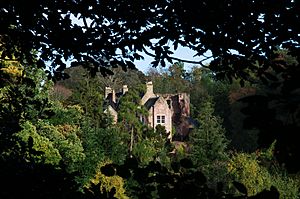Hawthornden Castle facts for kids
Quick facts for kids Hawthornden Castle |
|
|---|---|
| Midlothian, Scotland | |
 |
|
| Site history | |
| Built | 15th - 17th century |
| Built by | Douglas family Sir William Drummond of Hawthornden |
| Materials | Pink |
Hawthornden Castle is a historic building found in Midlothian, Scotland. It sits on the banks of the River North Esk, not far from Roslin Castle. This unique place combines parts of a 15th-century castle ruin with a house built in the 17th century.
Today, the house has been carefully fixed up and is used as a special place where writers can come to work. Even older than the castle are the man-made caves carved into the rocks below it. People have used these caves for a very long time!
Contents
History of Hawthornden Castle
Hawthornden Castle has a long and interesting past. It first belonged to the Abernethy family in the 1200s. Later, in the 1300s, it became the property of the Douglas family.
Early Castle Days
The oldest parts of the castle were built in the 1400s. These include a tall, three-story tower and a strong wall that was part of a triangular courtyard. The castle faced tough times in the 1540s. It was attacked and damaged twice by the Earl of Hertford during a conflict known as The Rough Wooing.
In 1540, the Douglas family sold trees from the Hawthornden woods to King James V. He used the timber to build ships. Later, the castle was sold to Sir John Drummond, who worked for King James VI.
A Poet's Home
Sir William Drummond of Hawthornden, a famous poet, was born at the castle. He made the castle bigger, adding a new section in 1638. This new part likely replaced older buildings. In 1618, another well-known English poet, Ben Jonson, came to visit William Drummond here. Much later, in the 1700s, the famous writer Dr Johnson also visited Hawthornden.
The house has been changed many times over the years. In the mid-1800s, it had a big update. In 1795, Dr William Abernethy Drummond, who was a bishop, added the Abernethy family's coat of arms above a door. He also put up a memorial for his ancestors, Sir William Drummond and Sir Lawrence Abernethy.
Modern Times at the Castle
The Drummond family owned Hawthornden Castle until the early 1970s. After the last Drummond passed away, the castle was sold to Douglas Adamson, an antiques dealer. His family lived there and even opened it to the public.
In the mid-1980s, the castle was sold again, this time to Drue Heinz. She was a big supporter of the arts. She had the castle restored and turned it into the Hawthornden Literary Retreat. This is a quiet place where writers can stay and focus on their work. Some of the stone used for the recent repairs came from an old railway station in Edinburgh.
Today, Hawthornden Castle and its caves are considered a very important historic site in Scotland.
Castle Design and Features
Hawthornden Castle is built on a rocky point next to the River Esk. It has a courtyard that is roughly triangular, about 24 meters long.
The Old Tower
At one corner of the courtyard is the 15th-century tower. This tower is mostly a ruin now, but during recent repairs, a library was added to its basement. Below the tower, there's also a prison pit with a special arched ceiling. Windows on one of the courtyard walls show that other buildings used to stand there, but they are now gone. A well at the other end of the courtyard provided water for the castle.
The Main House
The main house, built in the 16th century, is on the north side of the castle. It connects to the old tower with a wall from the same period, where the main entrance is located. This part of the castle has three stories and an attic. The fancy doorway was added later, and it has an iron knocker with the initials of Sir William Drummond (the poet's son) and his wife. There are also small openings called gunports around the doorway, which were used for defense. A smaller building was added to the west side of the castle in the late 1700s or early 1800s.
Mysterious Caves
Beneath Hawthornden Castle, there are several caves that were carved by people.
The Doocot Cave
One of these caves was used as a doocot, which is a place where pigeons or doves are kept. It has 370 little spaces for the birds!
Famous Visitors to the Caves
There's a story that King Robert the Bruce and Sir Alexander Ramsay of Dalhousie once hid in the caves under the castle. Another cave nearby is known as Wallace's Cave, named after the Scottish hero William Wallace.
Images for kids


